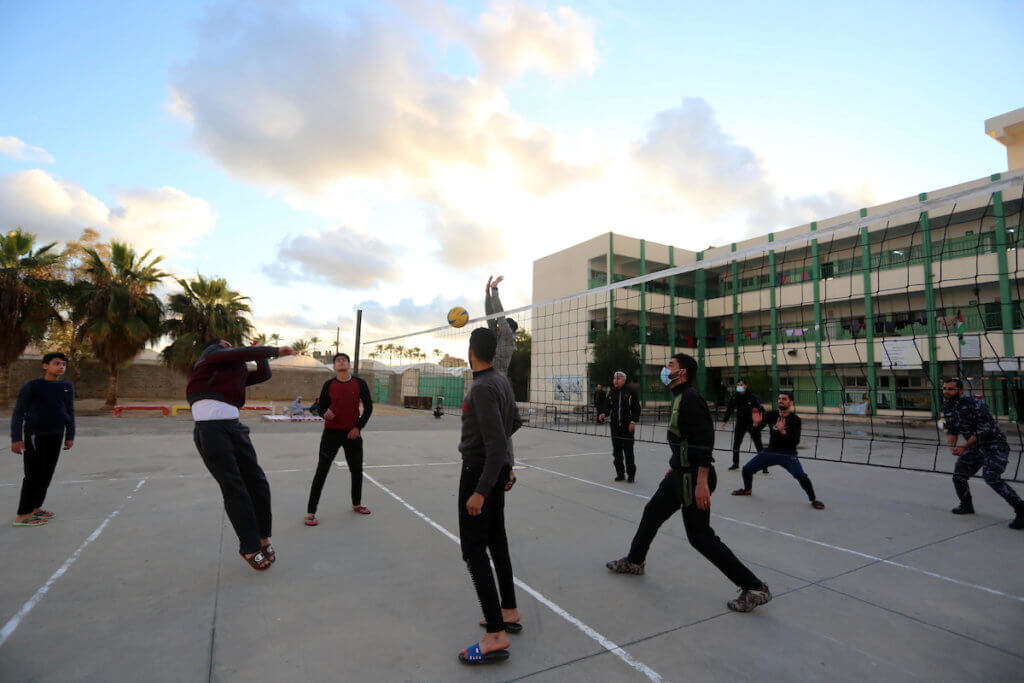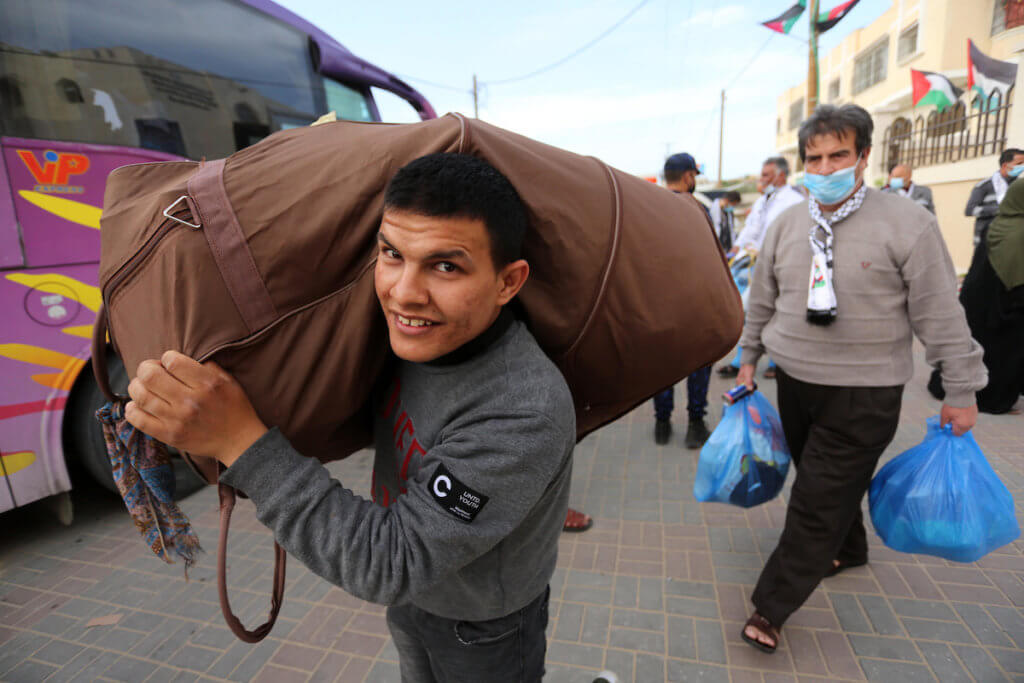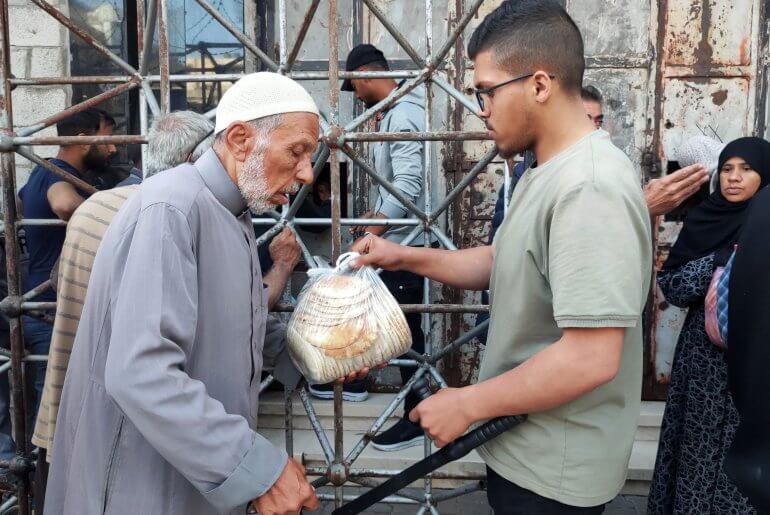Intense heat, insect infestations and boredom are some of the descriptions of government-run isolation centers in the Gaza Strip, according to Palestinians who were recently released from and are still under quarantine.
Many praised the healthcare teams who treated them, spending around a month holed up in hospitals, schools, and hotel rooms. Most had access to the internet and could make phone calls to relatives, although some did not. Mohammed al-Madhoun, a returning medical student who is in isolation at a school, told me over the phone, “We mix with other people inside the quarantine center and if it turned out that one of us is infected that would mean infecting many others.”
“Schools are not equipped well enough to provide for people for 21 days. We don’t even have a good internet connection, I can’t follow-up with my university or submit my assignments,” he said.
Many of the returning travelers in government isolation are Palestinians recovering from surgeries abroad and their companions.
Amjad Musallam had a brain tumor surgically removed at the onset of the pandemic, which set in motion a series of events that would require the 11-year-old to live in government isolation centers in Gaza for a combined total of two months.
On March 17 he traveled from his home in the Jabalia refugee camp to Israel for the operation with his grandfather, Lafty Musallam, 65, who came along as his guardian. At the time of the trip, Amjad had waited six months for a permit to exit Gaza via the northern Erez checkpoint. Time was of the essence, his tumor had blocked his vision in one eye and without intervention, he would have lost sight in both eyes.
When he and his grandfather returned to Gaza they were quarantined inside a sparsely furnished school in the southern Gaza Strip in Khan Younis.
“Amjad was missing his mother and asking her to visit him in the quarantine center,” Lafty Musallam said. “He cried a lot at night and wanted to return home, but there was nothing I could do for him.”
Amjad spent 21 days in quarantine. By the end of April, he had to travel back to Hadassah hospital in Jerusalem, this time with his mother Khaloud Musallam, 32 and his grandmother.
His mother told me, “The doctor told me that Amjad needs to be away from any psychological stress, especially crying.”
For the second time, Amjad is in quarantine, presently at a hotel in Gaza city with his mother and grandmother.
Over the telephone Amjad said, “This time quarantine is better. My mother is with me and the hotel is near the sea, it looks beautiful. I hope to recover soon and keep seeing things.”


Other Palestinians described isolation in a hospital where they were treated for an active COVID-19 infection. What’s more, doctors treating COVID-19 positive patients detail arduous working conditions, from staff shortages to severe limitations in medications.
A total of 72 Palestinians in Gaza have tested positive for COVID-19, of whom all were identified by staff at isolation centers. One patient died, a 77-year-old woman who was being treated at a hospital in Rafah.
In January this year, Fatma, 67, and her sister Mariam, 65, (their names have been changed for privacy purposes) left Gaza for Egypt. Fatima had joint replacement surgery in both of her legs at the Ain Shams Specialized Hospital in Cairo. Mariam’s surgery was successful, enabling her to walk for the first time in three years, yet required two months of intensive medication and rehab in Egypt.
Fatma described the overall quarantine conditions as “good but boring. We have experience in staying at home because we witnessed three Israeli wars,” she said in reference to three was between Israel and Gaza from 2008 to 2014.
Their journey to a government isolation center began in April when the two sisters returned to Gaza during a brief opening of the Rafah crossing to Egypt. Gaza has been under an Egyptian and Israeli imposed siege since 2007 and crossings in and out of the occupied territory are limited. When they crossed the border, they found heavy precautions to limit the entry of the coronavirus. Medical crews conducted an initial diagnostic test for symptoms related to a COVID-19 infection. They two were then moved to an isolation center in the city of Rafah, adjacent to the checkpoint of the same name, where Mariam tested positive for COVID-19 and Fatima tested negative.
Next, another medical crew moved the two women via a sterilized ambulance to a field hospital inside the Rafah crossing.
“It wasn’t an option for me to leave my sister, we traveled together and there’s no way to return without her,” said Fatima who had to convinced medical staff to allow her into the facility intended for only COVID-19 positive patients, although she was prohibited from entering the intensive care unit where her sister was treated.
“I understood the position Fatma was in and we managed to let her stay close to her sister without putting her in danger of infection,” said Muhammad Daher, the head doctor at the field hospital and an intensive care physician. Mariam was the first of ten COVID-19 positive patients he treated on his first day at the field hospital. He worked alongside a skeleton crew of two more doctors, three nurses, and four janitors. One doctor and one janitor had quit on their first day.
“The field hospital was originally a military hospital that’s already equipped. What exhausted us the most were high temperatures and insects,” told me in an interview over the telephone. The field hospital was closed to reporters.
“The first day of work was terrifying for me,” he continued, describing difficulty with his protective gear.
“I couldn’t see very well because of the steam coming out from my mouth while breathing and wearing a plastic face shield. I wasn’t able to see patients’ facial features well and that was difficult and new to me, and I wasn’t feeling comfortable in how I was dealing with patients,” Daher said.
“I had to compose myself quickly, as it’s important for the psychological status of the patients,” he said.
The second day on shift another four tested positive for COVID-19.
“I thought of all possibilities, including the fact that I may never return home again, but I decided to go on and only think about following up the cases and controlling the spread of the disease,” Daher said.
After a week there were 17 patients with COVID-19 at the field hospital.
After a little more than two weeks, Daher and the entire team staffing the hospital were released from duty and told to isolate in a government facility for 14 days before being allowed to return home. Another crew was brought in to replace them. All of their patients except for one had recovered.
“During 16 days of work, we only slept for around 48 hours distributed across all of the working days,” Daher said.

Palestinian doctors in Gaza work under extraordinary circumstances. Daher receives only 60 percent of his salary. A spokesperson for the ministry of health in Gaza Ashraf al-Qedra confirmed a crisis in capacity over shortfalls to their budget from the Palestinian Authority based in the West Bank. Gaza, while administered by Hamas, receives a substantial portion of the local health ministry budget from the PA.
“Since the beginning of 2020, we only received 5 percent of our annual needs from the ministry in Ramallah,” al-Qedra said.
Since the onset of the crisis health officials in Gaza required all returning Palestinians to isolate. Those ordered into one of 16, now 14 active, government-administered centers were kept away from the general public for 21 days or 28 days in the event that no COVID-19 tests were available.
In total 93,916 Palestinians in the West Bank and Gaza were ordered into isolation at either their homes or a government facility. As of June 2, there are still 1,460 Palestinians in government-run isolation, of whom around 100 are receiving medical treatment for preexisting conditions.

Sarah Algherbawi
Sarah Algherbawi is a freelancer writer and translator from Gaza.




I believe that’s volleyball they’re playing, not “basketball.”
Coronavirus update:
Israel : active cases: 3380
fatalities:300
PA : active cases:74
fatalities: 3